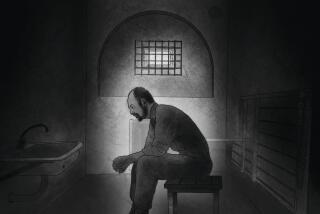Secret KGB Files to Reveal Fate of Stalin’s Victims
MOSCOW — In the dank tunnels beneath the KGB headquarters lie the moldering documents, perhaps ruined by seepage or soiled by rat droppings, that could explain to Vladimir Yanin why he was arrested at 16 as “the son of an enemy of the people” and why his stepfather was shot.
At least, that is what Yanin dares to hope, now that the KGB files on the millions who fell victim to Josef Stalin’s brutal dictatorship are about to be opened.
“We need the archives to know the truth,” the vigorous pensioner with a shock of white hair said Tuesday. “We want to find out about the mechanism of repression--but not only that. We want to create a white book, with the history of all the people who were repressed.
“And not only a white book but also a black book, with all the organizers of the repressions and the interrogators who were sadists and tortured people.”
Volya Lebedinsky, a 17-year veteran of the infamous gulag labor camp system, put in vehemently: “The ones who crushed us and stabbed us and wouldn’t let us sleep.”
It is not revenge they are seeking, said the members of the Union of Victims of Unjustified Repression who had gathered Tuesday in the Moscow headquarters of the Memorial Society, the country’s most prominent group seeking to redress the wrongs of the Stalin era and fight neo-Stalinism.
“Our task is to make sure that such repression can never be repeated,” said Artyom Feldman, who spent six years in a labor camp in Kazakhstan.
Hobbled by age and illness, the members of the Union of Victims got a terrible scare during last month’s coup. Many of them were sure they would be immediately arrested as enemies of the KGB and the Communist Party.
After the coup’s failure, a crowd enraged at the institutions that supported it brought down the 14-ton statue of the KGB’s founder, Felix E. Dzerzhinsky. Vadim V. Bakatin, a relative liberal who is the new chief of the KGB, pledged to virtually close down the agency’s secret police functions and open all its archives except the lists of its agents.
The Memorial Society, with its team of researchers into Stalin era crimes, has been promised access to the archives as soon as arrangements can be worked out, and groups like the victims’ union also expect to be allowed entry.
“Our hands our itching to get at them,” said Alexei Tokarev, co-chairman of the Memorial Society’s Moscow branch.
But at the same time, he said, the society’s 100 or so Moscow activists know they have nowhere near the resources needed for the herculean task of sifting through the decades of Stalinist detritus believed to lie under the KGB’s headquarters-cum-prison, known as the Lubyanka.
All the KGB archives taken together could amount to “millions and millions of cases,” Tokarev said. “And we don’t know what level of preservation they are in--what was destroyed and what was not--though they assure us it’s all there, it’s all been kept.”
He added: “The Lubyanka archives alone probably have a wild amount of papers because so many people went through it--thousands of people per day in 1937 and ’38. That’s all there, under Dzerzhinsky Square, in those tunnels.”
Tokarev said society members know that the tunnels exist because they wanted to turn a building across from the KGB headquarters into a museum. When they went to the basement, where thousands of Stalin’s victims had been shot, they saw the network of tunnels beginning in its bowels and leading to the Lubyanka.
Tokarev said that because of the underground conditions and typical Soviet negligence, he fears that many of the documents may have been lost to the elements.
But the potential physical condition of the archives and the tremendous labor in store has not diminished the thirst for information about the victims of repression.
“The main thing is the case reports that would show how it all started, who did the first denunciation, how it was all organized,” Feldman said. “Who was the person who stood at the heart of it all?”
“We want the KGB to tell us exactly how many cases of political repression there were,” Lebedinsky said. “How many were shot, how many died. We don’t even know many of their last names.”
So many people in Lebedinsky’s family were shot or died in the camps that “we practically have no grave with our name on it,” he said.
In Yanin’s family, four relatives were shot to death and six others, including his mother, were sent to the camps. He was exiled to Kazakhstan for 10 years. Now, he said, when he wants to lay flowers somewhere in his family’s memory, he does not even know which of 13 mass execution spots in Moscow he should visit.
The KGB had promised to provide the group with more information on the mass killings, he said, but so far officials have been dragging out the process, providing data on only 800 people a year out of an estimated 200,000 shot in Moscow alone.
Despite their interest, the group members also warned that great care has to be taken with the files to protect the innocent.
“There’s a lot of basic dirt in them,” Feldman said. “Who lived with whom, who slept with whom, a lot of it made up.”
After a long struggle with the Moscow KGB, many of the 4,000 members of the Moscow victims’ union have gained access to their own files and been individually exonerated of all crimes. But they hope that others can avoid this struggle.
In any case, Feldman said, the main value of the archives will be a collective one, “to show just how much this genocide cost us.”
Tokarev, too, said that archives should serve to help people understand the horror of their own history in a deeper way.
“This is the history of our common disease,” he said. “And I’m convinced that until we realize that it really is the disease of every one of us, of each of us--not the sins of some distant great-uncle who lived in some other world--and we’re clean, until we realize it’s everyone’s disease, society cannot be cleansed.”
More to Read
Sign up for Essential California
The most important California stories and recommendations in your inbox every morning.
You may occasionally receive promotional content from the Los Angeles Times.










